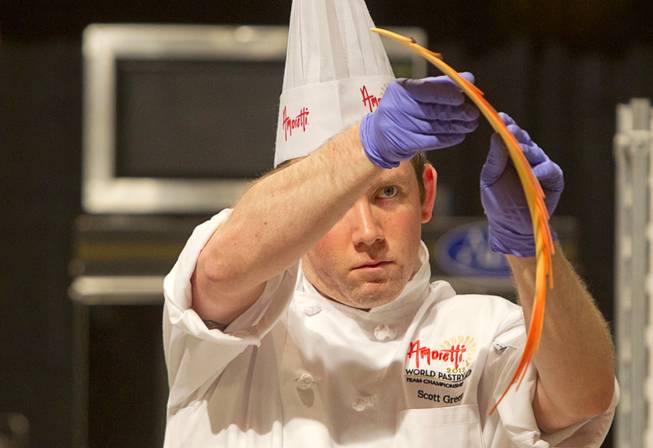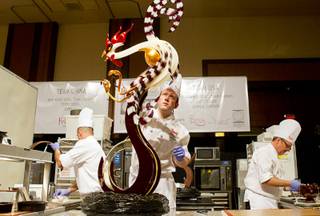
Scott Green of Team USA checks out the wings for a rooster sculpture during the Amoretti World Pastry Team Championship at Red Rock Resort Monday, July 9, 2012.
Published Monday, July 9, 2012 | 6:45 p.m.
Updated Monday, July 9, 2012 | 9:01 p.m.
The sound of crumbling, crystallized confection was not sweet.
Groans of anguish roared through the ballroom as a lifetime of training and more than a year of preparation showed itself as a heap of shattered sugar. For Team South Korea, it was the equivalent of a gymnast falling from the balance beam, an ice skater falling on the ice.
Pastry sculpture at this level is an intense, suspenseful art. Hundreds who gathered to watch the World Pastry Team Championship Monday at Red Rock Resort grimaced and held their breath while watching seven teams make intricate sculptures out of pure sugar and chocolate, meticulously and delicately put together over two days.
Then they had to move the pieces, meaning 13 hours of painstaking work could shatter.
"These pieces are more fragile than glass," said Gary Guittard, whose family has made chocolate for five generations, and whose California company provided the materials for Team USA.
The pastry chefs train like Olympians. They have coaches. They spend a year or more designing pieces, first on paper, then using three-dimensional computer models and making prototypes of foam or cardboard.
"These chefs put their lives on hold and immerse themselves in the competition, hoping they can move to the next level of their careers," said Alicia Boada, technical consultant for chocolate giant Barry Callebaut.
Michael Schneider, producer of the world championships, compared sculpting the sugar and chocolate creations to the intricacies of glass blowing. Then add pressure.
"You give them 13 hours to create something in front of an audience, judges staring at them every two seconds and a clock that doesn’t stop," Schneider said.
Teams from China, Japan, Netherlands, Mexico, Morocco, South Korea and the United States worked in front of groups of excited fans. Japanese painted their faces with the national flag. Americans chanted “U-S-A!”
The South Koreans saw their chocolate piece break as they moved it to the judging table. Their pure sugar sculpture made it to the table, before crashing.
But the team still was able to score points. The teams of three pastry chefs had spent two days prior making bonbons and various cakes and desserts. Judges also gauge how they work in the kitchen.
"They watch for hygiene, they watch how they carry themselves, the professionalism," Schneider said.
In the end, Japan won the competition with the team of chefs Tetsuya Seno, Hisashi Onobayashi and Koji Fujita. Team USA took second, followed by the Netherlands.
Temperature is key to holding everything together. Chocolate is tempered, or crystallized, through a heating process to make it into a substance that can be molded. Sugar has to be boiled to about 320 to 340 degrees to gain proper consistency.
Points are scored 40 percent on taste, 30 percent on artistic design and 30 percent on kitchen performance.
Like with any elite competition, victory tastes the sweetest.
"These teams go through their entire careers to advance their skills little by little, and the pinnacle of their career is to compete," Boada said. "When they win, their careers take off into dynamic directions."
Situated at the entrance to Red Rock Canyon and minutes from the world-renowned Las Vegas Strip, Red Rock Casino, Resort & Spa offers five-star luxury in a modern property, built in 2006.
The casino features features 3,000 slot and video poker machines, 60 table games including blackjack, baccarat, craps, poker, roulette, a 206-seat Race and Sports Book with a 96-foot video wall a 20-table smoke-free poker room open 24 hours a day, a 600-seat bingo hall with separate smoking and non-smoking sections, open 7 days a week with sessions running every other hour from 9 a.m. to 11 p.m., a 20-seat keno lounge and a private high-limit room.
A recipient of the AAA Four Diamond Award since opening and named one of the world's best new hotels by Conde Nast Traveler magazine, Red Rock redefines casino resort architecture by incorporating natural light, a convenient layout and the comforts of a modern lifestyle.
The centerpiece of the property is the three-acre pool complex with 19 cabanas and swim-up gaming. Its location allows for balcony views from several of the property's restaurants and Cherry Nightclub. Aside from Cherry, guests can grab a drink at Onyx or Lucky or listen to live music in Rocks Lounge.
Dining spans the globe at Red Rock with more than 10 restaurants, including the Italian food of Terra Rossa, the Japanese fusion of Hachi, the Mexican spices at Cabo Cantina or a bit of everything at the Feast Buffet.
Unlike some resorts in town, Red Rock has activities for the whole family, such as a 16-screen movie theater and an arcade. The 72-lane bowling center features a VIP area and carpet that glows in the dark for after hours at Cosmic Bowling.


Join the Discussion:
Check this out for a full explanation of our conversion to the LiveFyre commenting system and instructions on how to sign up for an account.
Full comments policy